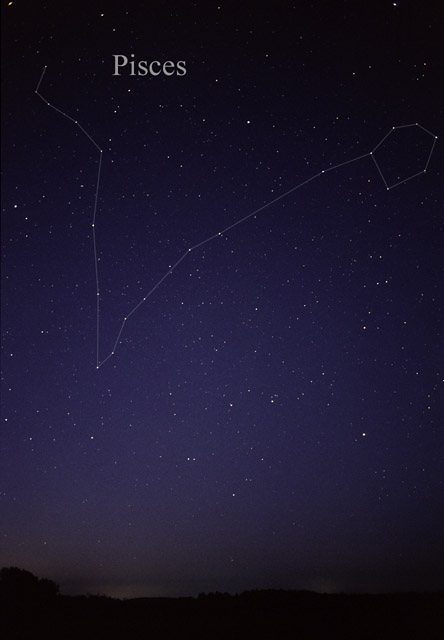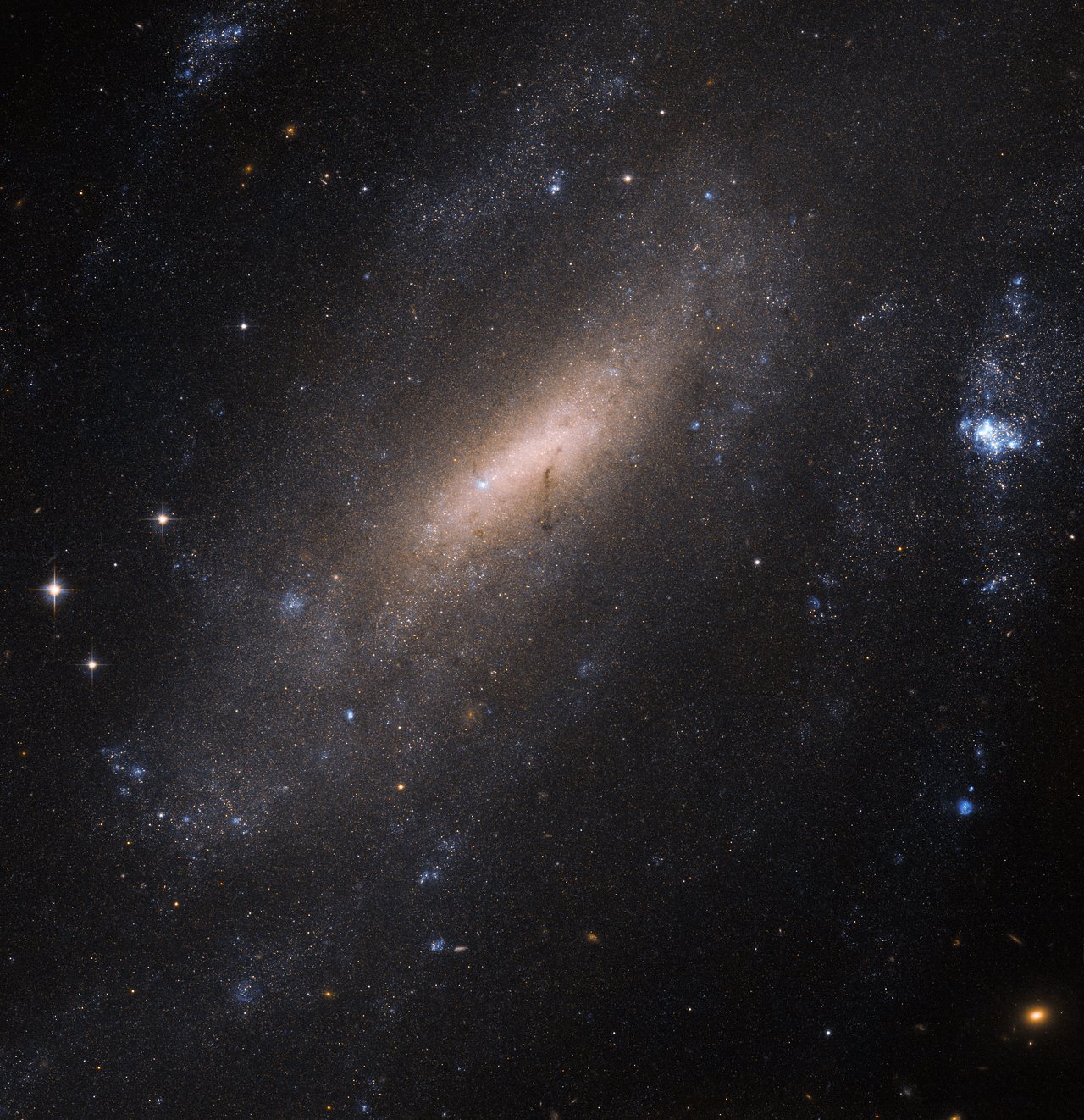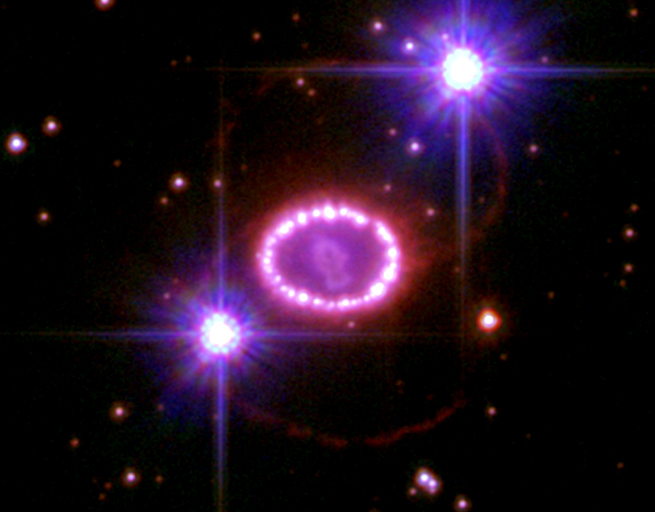|
SN 2005gl
SN 2005gl was a supernova in the barred-spiral galaxy NGC 266. It was discovered using CCD frames taken October 5, 2005, from the 60 cm automated telescope at the Puckett Observatory in Georgia, US, and reported by Tim Puckett in collaboration with Peter Ceravolo. It was independently identified by Yasuo Sano in Japan. The supernova event took place sometime between September 10 and October 5 of 2005. It was located 29.8 east and 16.7 north of the galactic core.Based upon its spectrum, this was classified as a Type II supernova, Type IIn core-collapse supernova. It has a redshift of ''z'' = 0.016, which is the same as the host galaxy. Using archived images from the Hubble Space Telescope, a candidate progenitor star was identified. This is believed to have been a luminous blue variable (LBV), similar to Eta Carinae, with an absolute magnitude of −10.3 and a surface temperature of about 13,000 K. There was a small probability that the source was instead lo ... [...More Info...] [...Related Items...] OR: [Wikipedia] [Google] [Baidu] |
J2000
In astronomy, an epoch or reference epoch is a moment in time used as a reference point for some time-varying astronomical quantity. It is useful for the celestial coordinates or orbital elements of a celestial body, as they are subject to perturbations and vary with time. These time-varying astronomical quantities might include, for example, the mean longitude or mean anomaly of a body, the node of its orbit relative to a reference plane, the direction of the apogee or aphelion of its orbit, or the size of the major axis of its orbit. The main use of astronomical quantities specified in this way is to calculate other relevant parameters of motion, in order to predict future positions and velocities. The applied tools of the disciplines of celestial mechanics or its subfield orbital mechanics (for predicting orbital paths and positions for bodies in motion under the gravitational effects of other bodies) can be used to generate an ephemeris, a table of values giving ... [...More Info...] [...Related Items...] OR: [Wikipedia] [Google] [Baidu] |
NGC 266
NGC 266 is a massive barred spiral galaxy in the constellation Pisces. NGC 266 is located at a distance of from the Milky Way. It was discovered on September 12, 1784, by William Herschel. The form of this barred galaxy is described by its morphological classification of SB(rs)ab, which indicates a quasi-ring-like structure (rs) and moderate-to-tightly wound spiral arms (ab). According to A.M. Garcia, NGC 266 is a member of the NGC 315 Group (also known as LGG 14). This group contains 42 galaxies, including NGC 226, NGC 243, NGC 262, NGC 311, NGC 315, NGC 338, IC 43, IC 66, AND IC 69, among others. Also, a 2013 paper lists NGC 266 as the dominant member of a small group with six low-mass galaxies. NGC 266 is an LINER-type active galaxy. It has a moderate star formation rate estimated at ·yr−1. A diffuse X-ray emission from hot gas has been detected around this galaxy, extending out to a radius of at least 70,000 light years. This emission not being driven ... [...More Info...] [...Related Items...] OR: [Wikipedia] [Google] [Baidu] |
Pisces (constellation)
Pisces is a constellation of the zodiac. Its vast bulk – and main asterism viewed in most European cultures per Greco-Roman antiquity as a distant pair of fishes connected by one cord each that join at an apex – are in the Northern celestial hemisphere. Its old astronomical symbol is (♓︎). Its name is Latin for "fishes". It is between Aquarius (constellation), Aquarius, of similar size, to the southwest and Aries (constellation), Aries, which is smaller, to the east. The ecliptic and the celestial equator intersect within this constellation and in Virgo (constellation), Virgo. The Sun subsolar point, passes directly overhead of the equator, on average, at approximately this point in the sky, at the March equinox. The right ascension/declination 00 is located within the boundaries of Pisces. Features The March equinox is currently located in Pisces, due south of Psc, and, due to precession, slowly drifting due west, just below the western fish towards Aquari ... [...More Info...] [...Related Items...] OR: [Wikipedia] [Google] [Baidu] |
Supernova
A supernova (: supernovae or supernovas) is a powerful and luminous explosion of a star. A supernova occurs during the last stellar evolution, evolutionary stages of a massive star, or when a white dwarf is triggered into runaway nuclear fusion. The original object, called the ''progenitor'', either collapses to a neutron star or black hole, or is completely destroyed to form a diffuse nebula. The peak optical luminosity of a supernova can be comparable to that of an entire galaxy before fading over several weeks or months. The last supernova directly observed in the Milky Way was Kepler's Supernova in 1604, appearing not long after Tycho's Supernova in 1572, both of which were visible to the naked eye. The supernova remnant, remnants of more recent supernovae have been found, and observations of supernovae in other galaxies suggest they occur in the Milky Way on average about three times every century. A supernova in the Milky Way would almost certainly be observable through mo ... [...More Info...] [...Related Items...] OR: [Wikipedia] [Google] [Baidu] |
Barred-spiral Galaxy
A barred spiral galaxy is a spiral galaxy with a central bar-shaped structure composed of stars. Bars are found in about two thirds of all spiral galaxies in the local universe, and generally affect both the motions of stars and interstellar gas within spiral galaxies and can affect spiral arms as well. The Milky Way Galaxy, where the Solar System is located, is classified as a barred spiral galaxy. Edwin Hubble classified spiral galaxies of this type as "SB" (spiral, barred) in his Hubble sequence and arranged them into sub-categories based on how open the arms of the spiral are. SBa types feature tightly bound arms, while SBc types are at the other extreme and have loosely bound arms. SBb-type galaxies lie in between the two. SB0 is a barred lenticular galaxy. A new type, SBm, was subsequently created to describe somewhat irregular barred spirals, such as the Magellanic Clouds, which were once classified as irregular galaxies, but have since been found to contain barred spiral ... [...More Info...] [...Related Items...] OR: [Wikipedia] [Google] [Baidu] |
Puckett Observatory
Puckett Observatory is a private astronomical observatory located in the state of Georgia. It is owned and operated by Tim Puckett. Its primary observation goals are the study of comets and the discovery of supernovae. To facilitate the latter goal it sponsors the Puckett Observatory World Supernova Search whose astronomers have discovered 369 supernovae. Telescopes The Puckett Observatory houses two telescopes. The 60 cm (24") Ritchey–Chrétien telescope was custom engineered and built by Puckett, and took nine years to complete, going online full-time in 1997. The telescope features a new type of hybrid disk/band worm drive designed by Puckett in 1993. It is one of the largest telescopes in the state. The other observatory telescope includes a Celestron C-14 Schmidt–Cassegrain with a Software Bisque's Paramount ME Robotic Telescope System. World Supernova Search The Puckett Observatory World Supernova Search was formed in 1998, with its principal investigator b ... [...More Info...] [...Related Items...] OR: [Wikipedia] [Google] [Baidu] |
Japan
Japan is an island country in East Asia. Located in the Pacific Ocean off the northeast coast of the Asia, Asian mainland, it is bordered on the west by the Sea of Japan and extends from the Sea of Okhotsk in the north to the East China Sea in the south. The Japanese archipelago consists of four major islands—Hokkaido, Honshu, Shikoku, and Kyushu—and List of islands of Japan, thousands of smaller islands, covering . Japan has a population of over 123 million as of 2025, making it the List of countries and dependencies by population, eleventh-most populous country. The capital of Japan and List of cities in Japan, its largest city is Tokyo; the Greater Tokyo Area is the List of largest cities, largest metropolitan area in the world, with more than 37 million inhabitants as of 2024. Japan is divided into 47 Prefectures of Japan, administrative prefectures and List of regions of Japan, eight traditional regions. About three-quarters of Geography of Japan, the countr ... [...More Info...] [...Related Items...] OR: [Wikipedia] [Google] [Baidu] |
Type II Supernova
A Type II supernova or SNII (plural: ''supernovae'') results from the rapid collapse and violent explosion of a massive star. A star must have at least eight times, but no more than 40 to 50 times, the mass of the Sun () to undergo this type of explosion. Type II supernovae are distinguished from other types of supernovae by the presence of hydrogen in their spectra. They are usually observed in the spiral arms of galaxies and in H II regions, but not in elliptical galaxies; those are generally composed of older, low-mass stars, with few of the young, very massive stars necessary to cause a supernova. Stars generate energy by the nuclear fusion of elements. Unlike the Sun, massive stars possess the mass needed to fuse elements that have an atomic mass greater than hydrogen and helium, albeit at increasingly higher temperatures and pressures, causing correspondingly shorter stellar life spans. The degeneracy pressure of electrons and the energy generated by th ... [...More Info...] [...Related Items...] OR: [Wikipedia] [Google] [Baidu] |
Redshift
In physics, a redshift is an increase in the wavelength, and corresponding decrease in the frequency and photon energy, of electromagnetic radiation (such as light). The opposite change, a decrease in wavelength and increase in frequency and energy, is known as a #Blueshift, blueshift. The terms derive from the colours red and blue which form the extremes of the Visible spectrum, visible light spectrum. Three forms of redshift occur in astronomy and cosmology: Doppler effect, Doppler redshifts due to the relative motions of radiation sources, gravitational redshift as radiation escapes from gravitational potentials, and cosmological redshifts of all light sources proportional to their distances from Earth, a fact known as Hubble's law that implies the expansion of the universe, universe is expanding. All redshifts can be understood under the umbrella of Frame of reference, frame transformation laws. Gravitational waves, which also travel at Speed of light, the speed of light, a ... [...More Info...] [...Related Items...] OR: [Wikipedia] [Google] [Baidu] |
Hubble Space Telescope
The Hubble Space Telescope (HST or Hubble) is a space telescope that was launched into low Earth orbit in 1990 and remains in operation. It was not the Orbiting Solar Observatory, first space telescope, but it is one of the largest and most versatile, renowned as a vital research tool and as a public relations boon for astronomy. The Hubble Space Telescope is named after astronomer Edwin Hubble and is one of NASA's Great Observatories program, Great Observatories. The Space Telescope Science Institute (STScI) selects Hubble's targets and processes the resulting data, while the Goddard Space Flight Center (GSFC) controls the spacecraft. Hubble features a mirror, and its five main instruments observe in the ultraviolet, visible spectrum, visible, and near-infrared regions of the electromagnetic spectrum. Hubble's orbit outside the distortion of atmosphere of Earth, Earth's atmosphere allows it to capture extremely high-resolution images with substantially lower background lig ... [...More Info...] [...Related Items...] OR: [Wikipedia] [Google] [Baidu] |
Luminous Blue Variable
Luminous blue variables (LBVs) are rare, massive, evolved stars that show unpredictable and sometimes dramatic variations in their spectra and brightness. They are also known as S Doradus variables after S Doradus, one of the brightest stars of the Large Magellanic Cloud. Discovery and history The LBV stars P Cygni and Eta Carinae, η Carinae have been known as unusual variables since the 17th century, but their true nature was not fully understood until late in the 20th century. In 1922 John Charles Duncan published the first three variable stars ever detected in an external galaxy, variables 1, 2, and 3, in the Triangulum Galaxy (M33). These were followed up by Edwin Hubble with three more in 1926: A, B, and C in M33. Then in 1929 Hubble added a list of variables detected in Messier 31, M31. Of these, Var A, Var B, Var C, and Var 2 in M33 and Var 19 in M31 were followed up with a detailed study by Hubble and Allan Sandage in 1953. Var 1 in M33 was excluded as being too faint a ... [...More Info...] [...Related Items...] OR: [Wikipedia] [Google] [Baidu] |
Eta Carinae
η Carinae (Eta Carinae, abbreviated to η Car), formerly known as η Argus, is a stellar system containing at least two stars with a combined luminosity greater than five million times that of the Sun, located around distant in the constellation Carina. Previously a 4th-magnitude star, it brightened in 1837 to become brighter than Rigel, marking the start of its so-called "Great Eruption". It became the second-brightest star in the sky between 11–14 March 1843 before fading well below naked-eye visibility after 1856. In a smaller eruption, it reached 6th magnitude in 1892 before fading again. It has brightened consistently since about 1940, becoming brighter than magnitude 4.5 by 2014. At declination −59° 41′ 04.26″, η Carinae is circumpolar from locations on Earth south of latitude 30°S (for reference, the latitude of Johannesburg is 26°12′S), and is not visible north of about latitude 30°N, just south of Cairo (w ... [...More Info...] [...Related Items...] OR: [Wikipedia] [Google] [Baidu] |






